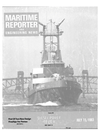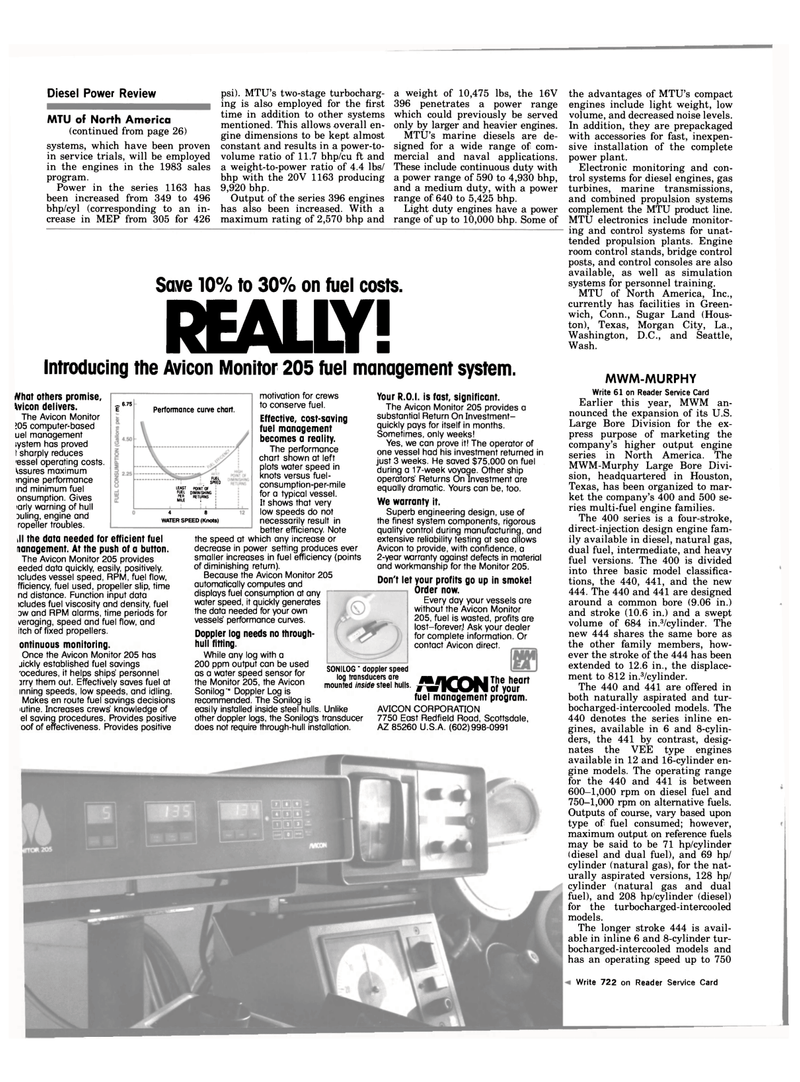
Page 22: of Maritime Reporter Magazine (July 15, 1983)
Read this page in Pdf, Flash or Html5 edition of July 15, 1983 Maritime Reporter Magazine
Diesel Power Review
MTU of North America (continued from page 26) systems, which have been proven in service trials, will be employed in the engines in the 1983 sales program.
Power in the series 1163 has been increased from 349 to 496 bhp/cyl (corresponding to an in- crease in MEP from 305 for 426 psi). MTU's two-stage turbocharg- ing is also employed for the first time in addition to other systems mentioned. This allows -overall en- gine dimensions to be kept almost constant and results in a power-to- volume ratio of 11.7 bhp/cu ft and a weight-to-power ratio of 4.4 lbs/ bhp with the 20V 1163 producing 9,920 bhp.
Output of the series 396 engines has also been increased. With a maximum rating of 2,570 bhp and a weight of 10,475 lbs, the 16V 396 penetrates a power range which could previously be served only by larger and heavier engines.
MTU's marine diesels are de- signed for a wide range of com- mercial and naval applications.
These include continuous duty with a power range of 590 to 4,930 bhp, and a medium duty, with a power range of 640 to 5,425 bhp.
Light duty engines have a power range of up to 10,000 bhp. Some of
Save 10% to 30% on fuel costs. REALLY!
Introducing the Avicon Monitor 205 fuel management system. _ 6.75
E
What others promise, \vicon delivers.
The Avicon Monitor !05 computer-based uel management ;ystem has proved t sharply reduces ressel operating costs.
Assures maximum ingine performance ind minimum fuel onsumption. Gives iarly warning of hull
Duling, engine and ropeller troubles. ill the data needed for efficient fuel management. At the push of a button.
The Avicon Monitor 205 provides eeded data quickly, easily, positively, lcludes vessel speed, RPM, fuel flow, fficiency, fuel used, propeller slip, time nd distance. Function input data icludes fuel viscosity and density, fuel
DW and RPM alarms, time periods for yeraging, speed and fuel flow, and itch of fixed propellers. ontinuous monitoring.
Once the Avicon Monitor 205 has jickly established fuel savings -ocedures, it helps ships' personnel ]rry them out. Effectively saves fuel at inning speeds, low speeds, and idling.
Makes en route fuel savings decisions iutine. Increases crews' knowledge of el saving procedures. Provides positive oof of effectiveness. Provides positive
Performance curve chart. motivation for crews to conserve fuel.
FUEL
SPIED
LEAST POINT'Of i
FUEL DIMINISHING J
PEP RETURNS '
MILE ; ! 4 B
WATER SPEED (Knots)
Effective, cost-saving fuel management becomes a reality.
The performance chart shown at left plots water speed in knots versus fuel- consumption-per-mile for a typical vessel.
It shows that very low speeds do not necessarily result in better efficiency. Note the speed at which any increase or decrease in power setting produces ever smaller increases in fuel efficiency (points of diminishing return).
Because the Avicon Monitor 205 automatically computes and displays fuel consumption at any water speed, it quickly generates the data needed for your own vessels' performance curves.
Doppler log needs no through- hull fitting.
While any log with a 200 ppm output can be used as a water speed sensor for the Monitor 205, the Avicon
Sonilog'" Doppler Log is recommended. The Sonilog is easily installed inside steel hulls. Unlike other doppler logs, the Sonilog's transducer does not require through-hull installation.
Your R.0.1. is fast, significant.
The Avicon Monitor 205 provides a substantial Return On Investment- quickly pays for itself in months.
Sometimes, only weeks!
Yes, we can prove it! The operator of one vessel had his investment returned in just 3 weeks. He saved $75,000 on fuel during a 17-week voyage. Other ship operators' Returns On Investment are equally dramatic. Yours can be, too.
We warranty it.
Superb engineering design, use of the finest system components, rigorous quality control during manufacturing, and extensive reliability testing at sea allows
Avicon to provide, with confidence, a 2-year warranty against defects in material and workmanship for the Monitor 205.
Don't let your profits go up in smoke!
Order now.
Every day your vessels are without the Avicon Monitor 205, fuel is wasted, profits are lost-forever,! Ask your dealer for complete information. Or contact Avicon direct.
SONILOG" doppler speed log transducers are mounted inside steel hulls. Alimj The heart M tv IVmi of your fuel management program.
AVICON CORPORATION 7750 East Redfield Road, Scottsdale,
AZ 85260 U.S.A. (602)998-0991 the advantages of MTU's compact engines include light weight, low volume, and decreased noise levels.
In addition, they are prepackaged with accessories for fast, inexpen- sive installation of the complete power plant.
Electronic monitoring and con- trol systems for diesel engines, gas turbines, marine transmissions, and combined propulsion systems complement the MTU product line.
MTU electronics include monitor- ing and control systems for unat- tended propulsion plants. Engine room control stands, bridge control posts, and control consoles are also available, as well as simulation systems for personnel training.
MTU of North America, Inc., currently has facilities in Green- wich, Conn., Sugar Land (Hous- ton), Texas, Morgan City, La.,
Washington, D.C., and Seattle,
Wash.
MWM-MURPHY
Write 61 on Reader Service Card
Earlier this year, MWM an- nounced the expansion of its U.S.
Large Bore Division for the ex- press purpose of marketing the company's higher output engine series in North America. The
MWM-Murphy Large Bore Divi- sion, headquartered in Houston,
Texas, has been organized to mar- ket the company's 400 and 500 se- ries multi-fuel engine families.
The 400 series is a four-stroke, direct-injection design engine fam- ily available in diesel, natural gas, dual fuel, intermediate, and heavy fuel versions. The 400 is divided into three basic model classifica- tions, the 440, 441, and the new 444. The 440 and 441 are designed around a common bore (9.06 in.) and stroke (10.6 in.) and a swept volume of 684 in.3/cylinder. The new 444 shares the same bore as the other family members, how- ever the stroke of the 444 has been extended to 12.6 in., the displace- ment to 812 in.3/cylinder.
The 440 and 441 are offered in both naturally aspirated and tur- bocharged-intercooled models. The 440 denotes the series inline en- gines, available in 6 and 8-cylin- ders, the 441 by contrast, desig- nates the VEE type engines available in 12 and 16-cylinder en- gine models. The operating range for the 440 and 441 is between 600—1,000 rpm on diesel fuel and 750-1,000 rpm on alternative fuels.
Outputs of course, vary based upon type of fuel consumed; however, maximum output on reference fuels may be said to be 71 hp/cylinder (diesel and dual fuel), and 69 hp/ cylinder (natural gas), for the nat- urally aspirated versions, 128 hp/ cylinder (natural gas and dual fuel), and 208 hp/cylinder (diesel) for the turbocharged-intercooled models.
The longer stroke 444 is avail- able in inline 6 and 8-cylinder tur- bocharged-intercooled models and has an operating speed up to 750
Write 722 on Reader Service Card

 21
21

 23
23
